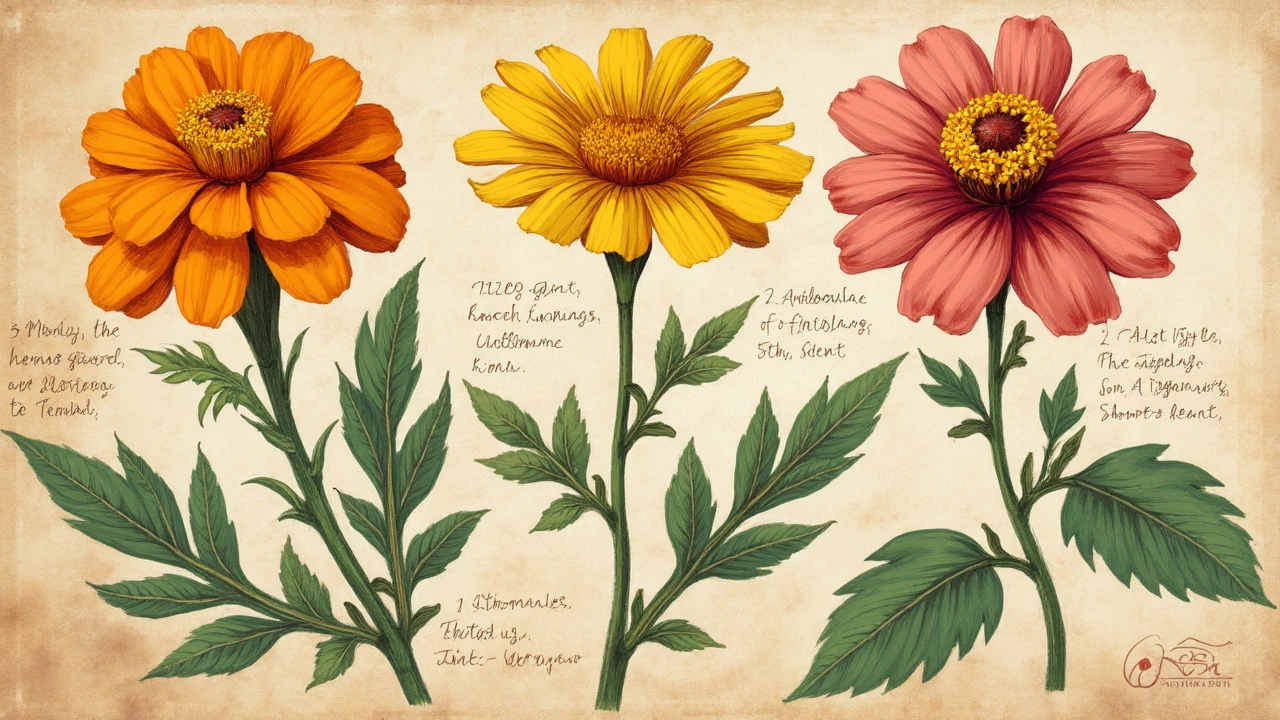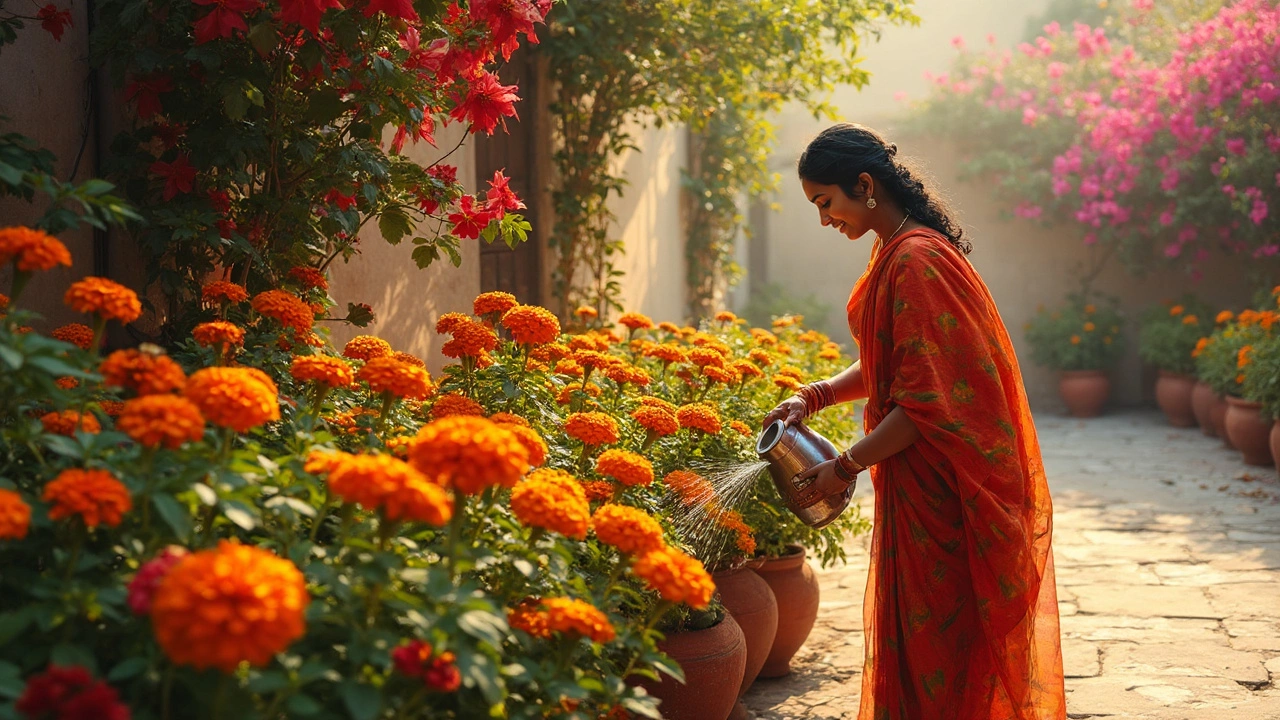If you’re tired of seeing your flowers droop after just a few days of sunlight, you’re not alone. The Indian sun is brutal on delicate blooms, and even seasoned gardeners get frustrated watching their garden fade away in the heat.
But here’s what most folks miss: not all flowers are weaklings when it comes to sunshine. In India’s relentless heat, some flowers don’t just survive—they actually look better than ever, their colors getting bolder the more they bake in the sun.
Your garden doesn’t have to be a lost cause just because summer’s here. It’s all about picking the right warriors for the job. Forget about European imports or delicate petunias for a moment. There are flowers basically built for the heat. Marigolds practically thrive in direct sunlight. Portulaca, known as the '10 O’clock flower,' actually opens its blooms wider under the sun’s glare. Bougainvillea? It lives to show off when most others just wilt.
Knowing which flowers to plant (and where to plant them) can totally change your gardening game. You’ll find your garden looking fresh even when temperatures hit 40°C. Ready to make your garden sunproof? Keep reading for the flowers that go the distance, plus some tough-love advice to keep those blooms looking their best.
- Why Most Flowers Fade in Indian Sun
- Flowers That Really Stand Up to Heat
- Tips for Growing Hardy Sun-Lovers
- Mistakes to Dodge in Hot-Weather Gardening
Why Most Flowers Fade in Indian Sun
India’s summer isn’t just hot—it’s harsh and punishing for most garden flowers. You’d think sun means bigger, brighter blooms, but when the mercury climbs over 40°C and humidity barely moves, most petals can’t keep up. The biggest enemy isn’t always the sun itself, but how much water and nutrients flowers can hang onto when it’s baking outside.
Petals are like the skin of a flower. Too much sun causes moisture loss, color bleaching, and sometimes actual burns. Leaves can wrinkle or turn yellow from dehydration, but flower petals just shrivel until they drop. Plants also need more water to keep cool, and if the soil dries out too fast (especially in clay or sandy patches), roots can't send enough up top to save the bloom.
- Thin, delicate petals (like those on pansies, petunias, and impatiens) lose water fast and disintegrate in days.
- Imported or temperate-zone flowering plants aren’t built for 10+ hours of blazing sunlight that’s common from April to June across much of the country.
- Even Indian classics can struggle when grown in pots or in spots with too much heat bouncing off cement or tiles.
Here are some hard numbers. Typical city summers (Delhi, Nagpur, Hyderabad) bring UV indices above 10 for weeks. That means even “full sun” plants from Europe can scorch. Local marigolds handle it better, but most others don’t, especially if temperatures stay high at night too.
| City | Average Summer High (°C) | Sunlight Hours/Day | UV Index (Peak) |
|---|---|---|---|
| Delhi | 41 | 9 - 11 | 11+ |
| Mumbai | 35 | 8 - 10 | 10 |
| Chennai | 39 | 9 - 11 | 11 |
If you want 🌸 flowers that don't fade 🌸, you’ll need to pick those that developed tough petals, waxy cuticles (covering), and deeper roots. Most common garden flowers just weren’t built for our sun—they evolved in cooler, mellower places. That’s why so many blooms fizzle once May rolls around.
Flowers That Really Stand Up to Heat
If there's one thing you learn fast while gardening in India, not all flowers are created equal. Some wilt and fade before lunchtime. Others, though, seem to treat blazing sunlight like a personal challenge. Let’s get real about which plants actually earn their spot in the sun.
Bougainvillea is the hands-down champion. It doesn’t just tolerate direct sunlight—it flourishes in it. All it needs is a little space to sprawl and a bit of pruning now and then. Once established, bougainvillea barely asks for water. In hot cities like Chennai or Hyderabad, it’s common to spot bougainvillea lighting up dusty walls with its crazy pink, purple, or white flowers well into the hottest months.
Marigolds are next. These bright yellow and orange icons aren’t just for puja plates. They’re your safest bet if you want a pop of color that sticks around when everything else looks fried. The African and French types both handle tough sunlight without flinching. Plus, marigolds are super easy to grow from seed and actually repel some garden pests.
Portulaca, nicknamed the '10 O’clock flower,' is a ground-hugging, no-nonsense plant that’s perfect for filling up space. It actually closes its blooms in the evening and opens them wide once the sun’s out. If you want a low-maintenance, sunproof ground cover, this one’s a winner. It grows fast, needs almost no water, and can even handle the bad soil Indian cities are known for.
Don’t overlook periwinkle (also called sadabahar). These little guys bloom continuously, even when the rest of your garden seems tired. The plants hardly ever get diseases and just want sunlight and the occasional watering. Periwinkle is actually used in traditional medicine too, so it’s practical beyond the looks.
If you like a little drama, zinnias are a great choice. Available in nearly every color except blue, zinnias keep blooming from early summer right into the rains. They don’t just look good; they also attract butterflies. Plant them in well-drained soil, water regularly when they’re getting started, and soon you’ll have a sea of bold, sun-loving blooms.
- flowers that don't fade in the Indian sun: Bougainvillea, Marigold, Portulaca, Periwinkle, and Zinnia.
- Bougainvillea handles poor soil and hates overwatering.
- Marigolds and zinnias grow easily from seed—great for beginners.
- Portulaca is best for hot balconies or traffic-heavy city spots where nothing else works.
- Periwinkle is super hardy and can handle almost any urban tough-love.
These picks are crowd favorites for a reason—their toughness isn’t hype. Pick any of these, and your garden has a fighting chance through the sweltering months.

Tips for Growing Hardy Sun-Lovers
Getting the most out of sun-tolerant flowers in India isn’t hard if you play by their rules. These plants want sunlight, but they also need a few basics to really put on a show. Let’s get straight to what works—and what’s a waste of your time.
- Soil drains fast: Hardy, sun-loving flowers like marigold, portulaca, gomphrena, and bougainvillea hate wet feet. Use sandy or loamy soil mixed with compost for best results. Compact, clayey soil is a no-go for these guys.
- Location is everything: Place containers and beds where there’s at least 6 hours of direct sunlight. If you’re not sure about your garden’s sun exposure, check a few different spots at noon—that’s usually peak sunlight.
- Water deeply, but not often: Most sunproof flowers develop deep roots to find their own water. Water deeply, then let the top inch of soil dry out completely before watering again. Portulaca and zinnia can rot if watered too often.
- Feed, but don’t over-feed: Use mild compost every 3-4 weeks. Skip heavy chemical fertilizers—too much nitrogen and you get tall, floppy stems instead of blooms.
- Pest patrol: Sun and heat don’t scare off mealy bugs and aphids. Marigolds are usually safe, but bougainvillea can get hit. Spraying neem oil every couple of weeks keeps things under control without harsh chemicals.
Check out this quick comparison to see how some popular hardy flowers in India stack up:
| Flower | Best Soil | Water Needs | Sunlight (hours/day) | Special Notes |
|---|---|---|---|---|
| Marigold | Well-drained, loamy | Medium, let soil dry out | 6-8 | Repels some garden pests |
| Portulaca | Sandy, poor soil fine | Very low | 6+ | Attracts bees, superb groundcover |
| Zinnia | Loose, rich soil | Medium | 6+ | Blooms all summer, deadhead for more |
| Bougainvillea | Quick draining, slightly acidic | Very low, drought-tolerant | 8+ | Prune hard for repeat blooms |
| Gomphrena | Well-drained, average | Low | 6-8 | Dried flowers last for months |
If you remember anything, remember this—strong sun doesn't equal high maintenance. Pick smart, plant right, and lay off the overwatering and heavy chemicals. Your flowers will handle the heat just fine.
Mistakes to Dodge in Hot-Weather Gardening
Trying to keep your garden alive during peak summer in India isn’t easy, but a lot of folks make the same mistakes and unknowingly sabotage their plants. Knowing what to dodge can save you wasted effort, money, and a lot of disappointment.
First big slip-up: watering in the middle of the day. When the sun is directly overhead, most of the water just evaporates before it even reaches the roots. It’s best to water early in the morning or late in the evening, so your flowers actually get to drink.
Next, some gardeners go overboard with mulching. Yes, mulch helps lock in moisture, but piling on a thick layer—especially with non-breathable materials—can actually suffocate the roots and lead to rot, not to mention making a cosy home for pests.
Another common mistake is crowding your flower beds. In the fight for sunlight and nutrients, packing sun-tolerant flowers like marigolds too close can backfire. It leads to poor air movement and a bigger risk of fungal issues. Give each plant its own space.
People also tend to use too much chemical fertilizer, thinking it’s a quick fix for weak plants. But high-nitrogen feeds can burn roots when the weather’s hot, and even damage your soil over time. Switch to lighter organic compost and feed less often during heatwaves.
Don’t forget about shade. Even the toughest flowers need a breather. Setting up temporary shade, like a bit of shade netting during mid-afternoon, can help flowers recover without getting scorched, especially if you’re in a region that regularly hits 40°C.
- Water early or late, never midday
- Keep mulch light – one or two inches max
- Space plants for airflow
- Go easy on chemical fertilizers
- Offer part-time shade for intense heat
Getting these basics right means your garden can stay bright, even in the hottest months. Sometimes, it’s less about what you do and more about what you avoid.

